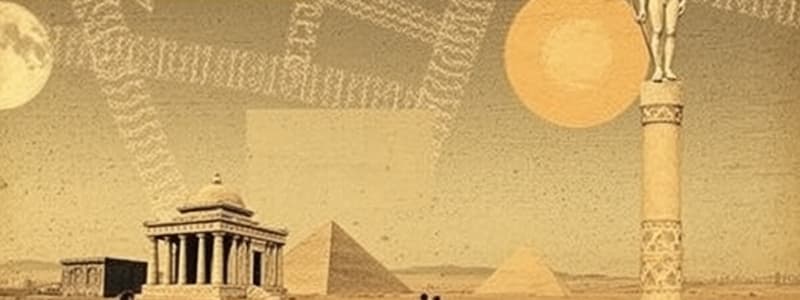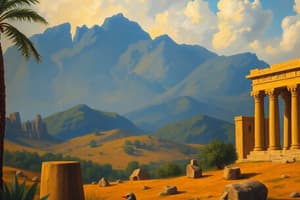Podcast
Questions and Answers
What was one significant impact of the development of writing systems in ancient civilizations?
What was one significant impact of the development of writing systems in ancient civilizations?
- It facilitated the spread of spoken language.
- It allowed for the recording of history, law, and knowledge. (correct)
- It reduced the need for technological innovations.
- It undermined artistic expression.
How did technological innovations affect ancient civilizations?
How did technological innovations affect ancient civilizations?
- They were primarily focused on artistic achievements.
- They had little to no impact on societal development.
- They primarily affected only agricultural practices.
- They showcased ingenuity and problem-solving abilities. (correct)
Which factor played a crucial role in the competition and conflict among ancient societies?
Which factor played a crucial role in the competition and conflict among ancient societies?
- The desire for control over resources and power. (correct)
- A shared interest in cultural preservation.
- The absence of social structures.
- The decline of trade routes.
What often resulted from the interactions between different civilizations?
What often resulted from the interactions between different civilizations?
What was a key transition that marked a turning point for human societies?
What was a key transition that marked a turning point for human societies?
Which civilization is known for its sophisticated writing system that is still undeciphered?
Which civilization is known for its sophisticated writing system that is still undeciphered?
What is a common characteristic found in the development of all ancient civilizations mentioned in the text?
What is a common characteristic found in the development of all ancient civilizations mentioned in the text?
Which ancient civilization is most notable for its contributions to philosophy and democratic governance?
Which ancient civilization is most notable for its contributions to philosophy and democratic governance?
What is a distinguishing feature of Ancient Egypt that sets it apart from other civilizations mentioned in the text?
What is a distinguishing feature of Ancient Egypt that sets it apart from other civilizations mentioned in the text?
Which of the following was NOT a characteristic of ancient civilizations?
Which of the following was NOT a characteristic of ancient civilizations?
What is a common feature of both ancient China and ancient Mesopotamia?
What is a common feature of both ancient China and ancient Mesopotamia?
Ancient Rome is well-known for its contributions to which areas?
Ancient Rome is well-known for its contributions to which areas?
What is the significance of the development of agriculture in ancient civilizations?
What is the significance of the development of agriculture in ancient civilizations?
Flashcards
Writing Systems
Writing Systems
Methods used to record language and preserve cultural knowledge.
Art and Architecture
Art and Architecture
Forms of expression showcasing societal values and technological progress.
Technological Innovations
Technological Innovations
New tools and methods that improve society's capabilities.
Cultural Exchange
Cultural Exchange
Signup and view all the flashcards
Social Structures
Social Structures
Signup and view all the flashcards
Ancient World Civilizations
Ancient World Civilizations
Signup and view all the flashcards
Mesopotamia
Mesopotamia
Signup and view all the flashcards
Ancient Egypt
Ancient Egypt
Signup and view all the flashcards
Indus Valley Civilization
Indus Valley Civilization
Signup and view all the flashcards
Ancient China
Ancient China
Signup and view all the flashcards
Ancient Greece
Ancient Greece
Signup and view all the flashcards
Ancient Rome
Ancient Rome
Signup and view all the flashcards
Key Characteristics of Civilizations
Key Characteristics of Civilizations
Signup and view all the flashcards
Study Notes
Overview of Ancient World Civilizations
- Ancient world civilizations represent a wide variety of societies, each with unique features and developments.
- These societies formed the basis for many cultural, political, and technological advancements.
- Key characteristics include agriculture, urban growth, political systems, social hierarchies, art, religion, and writing.
Key Ancient Civilizations
- Mesopotamia: Located between the Tigris and Euphrates rivers, known for city-states, irrigation systems, cuneiform writing, and advancements in mathematics and astronomy.
- Ancient Egypt: Situated in the Nile River valley, famous for monumental architecture (pyramids), hieroglyphic writing, complex religious beliefs, and a centralized government.
- Indus Valley Civilization: Thrived in the Indus River valley, characterized by well-planned cities, advanced urban planning, an (undeciphered) writing system, and sophisticated drainage systems.
- Ancient China: Developed along the Yellow River, emphasizing philosophy (Confucianism, Daoism), a centralized government, advancements in metallurgy and agriculture, and a complex writing system.
- Ancient Greece: Located on the Mediterranean, known for democratic governance, philosophical thought (Socrates, Plato, Aristotle), advancements in mathematics and science, and the development of drama and literature.
- Ancient Rome: Situated in Italy, built a vast empire, renowned for advanced engineering (roads, aqueducts), codified law, and significant contributions to language and government.
General Characteristics of Ancient Civilizations
- Agriculture: The development of agriculture was key for settled communities and population growth.
- Urbanization: Cities fostered trade, labor specialization, and social structures.
- Political Organization: As societies grew, centralized governments (monarchies, empires, republics) emerged.
- Social Hierarchy: Social classes developed, often connected to occupations and wealth.
- Religion: Religious beliefs strongly influenced daily life and often combined with political power and social customs.
- Writing Systems: Writing systems helped record history, laws, and knowledge, impacting culture's transmission.
- Art and Architecture: Artistic expression and monumental architecture reflected societal values, beliefs, and technological capabilities.
- Technology: Innovations like irrigation, metalworking, and large structures reflected ingenuity and problem-solving of ancient civilizations.
Interactions and Influences
- Civilizations interacted through trade, warfare, and cultural exchange.
- The exchange of ideas, goods, and technology led to cultural diffusion.
- Cultures often absorbed aspects of other groups, creating cultural blends.
Common Themes and Patterns
- The transition from nomadic to settled life was a critical moment in human history.
- Geography, environment, and resources influenced civilizations' development.
- Competition for resources and power frequently led to conflicts.
- Social structures and hierarchies determined power distribution.
Studying That Suits You
Use AI to generate personalized quizzes and flashcards to suit your learning preferences.




